Africatown
In the summer of 1928, Zora Neale Hurston conducted anthropological fieldwork near Mobile, Alabama at Africatown. The field site had been a suggestion of her academic advisor, Franz Boas, who proposed that she collect West African folklore from Africatown's most famous resident, Cudjo Lewis. Lewis, along with 109 other captive Africans, survived an Atlantic crossing aboard the Clotilda, the last documented slaver to make the Middle Passage. While reflecting on his 68 years on American soil and five years of enslavement, Lewis provided accounts of great loss; he had buried his three sons and his wife and longed to return to his boyhood home in Ghana. Lewis also described moments of great happiness such as when Confederates fled Mobile in April of 1865 and he recounted that …"After dey free us, you understand me, we so glad, we make de drum and beat it… [like we were on] African soil." The United Nations used this account in March of 2009 to commemorate the victims of the trans-Atlantic slavery and to illustrate resonate moments of Africans claiming their freedom. Despite early research interest by Hurston and recent attention by the United Nations, few attempts have been made to pose connections between Africatown and the African continent, describe the difficulties of forging a community within the post-Civil War American South, or compare Africatown with other 19th/20th century African Diaspora sites. Through fieldwork in January 2010 and again in the summer of 2010, members of the Africatown Archaeological Project worked to address these questions and aid the local descendant community in preserving cultural resources.
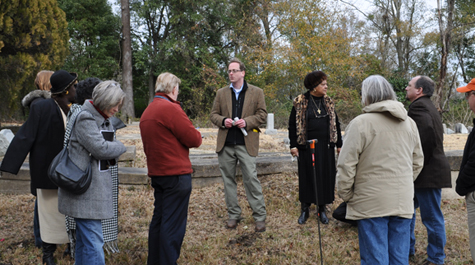 |
Dr. Neil Norman at Public Archaeology Day Discussing Research Methods at Old Plateau Cemetery, January 2010
|
From the outset project members adopted the client-based model proposed by Dr. Michael Blakey where community members define goals for fieldwork and approve methods. With virtual unanimity, stakeholders designated conservation, stabilization, and mapping at the Old Plateau Cemetery as the first priority. Several of the founders of Africatown are buried at Old Plateau, which makes it a point of pilgrimage and also potentially eligible for the National Register of Historic Places (NRHP). After a series of community meetings in the summer of 2009, the goals of the project were threefold: 1) document and map the marked and unmarked graves located within the cemetery 2) stabilize graves that are in immediate threat of destruction, or are a danger to the public and 3) develop an initial preservation assessment for the cemetery.
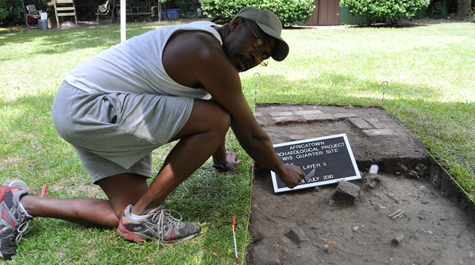 |
Mr. Gary Autery aiding with excavations on his Great -Grandfather's homesite in Lewis Quarter
|
In the winter and summer of 2010, project team members
cleared brush and monitored professional landscapers, who removed 20
years of overgrowth from the northern fifth of the cemetery. After
clearing, ground penetrating radar and sub-surface probing were used to
record unmarked graves. Project members then mapped grave-sites,
recorded headstone information, and photographed each grave. In total,
1699 graves were documented using these techniques.
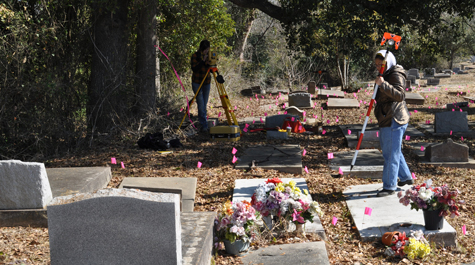 |
Alix Martin and Shea Winsett mapping graves at Old Plateau Cemetery |
Project members recorded four collapsed graves with
visible human remains and three vandalized graves with exposed caskets.
After consultation with local city officials, a mason was engaged to
repair and repoint exposed burials. As part of the stabilization
efforts, project members also developed a stabilization plan for the
gravesite of Innie Keeby, a survivor of the Clotilda crossing.
At the time of its recovery, the gravestone was in immediate danger of
eroding down a steep slope. Project members designed a bulkhead to
prevent further erosion. It is hoped that these emergency conservation
efforts will stabilize vulnerable graves for several decades. In coming
field seasons, we will monitor these efforts and attempt to provide
more context to unnamed and unmarked graves. At two archaeological
field-days in January and July 2010, Africatown community members helped
to identify unnamed and unmarked graves. These efforts are ongoing
through an interactive database on the Mobile African American Heritage
Trail website, which aims to harness the power of crowdsourcing for
archaeological problem solving.
Community stakeholders identified
the second priority of fieldwork as archaeological survey and testing
to evaluate the NRHP eligibility of early Africatown homesteads.
Initial research revealed that the Peter Lee Site would be an excellent
candidate for the NRHP in that it represents one of the vanishing few
cases where we have documented evidence of house sites linked across the
Atlantic diasporic divide. Gumpa, or Peter Lee as he was known in
Mobile, was born into Dahomean royalty in the early 19th century. He
was descended from Dahomean kings Glele and Benhazin. The royal house
of Dahomey profited greatly from the trans-Atlantic slave trade. Today,
palace complexes associated with the aforementioned kings are found at
Abomey in the Republic of Benin, West Africa and listed as UNESCO World
Heritage sites. However, Gumpa spent most of his life 90 km south of
Abomey at the coastal trading center at Ouidah. He lived at the
Dahomean administrative complex at Ouidah, which can be found today near
the Catholic Basilica and Temple of the Python. On a daily basis,
Gumpa managed the trade of captives and represented the Dahomean royal
line in such exchanges. In 1860, Gumpa fell out of favor with his
family in Abomey. As a punishment, Gumpa was traded into the Middle
Passage aboard the slaver Clotida. Today, a family house still
stands in Ouidah that relates to the royal line associated with Gumpa.
Likewise, a chimney stands on the highest ground in Africatown that
local oral history suggests relates to a house Gumpa built for himself
and his newly-constituted family.
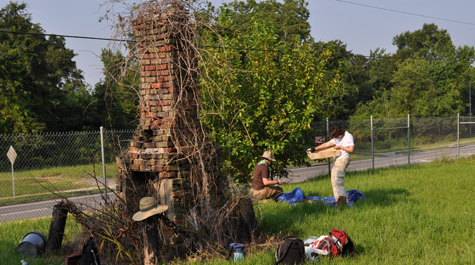 |
Megan Victor and Jennifer Saunders excavating Shovel TestPits at the Peter Lee House
|
In Africatown, Gumpa served as a central political leader of the
community. This was the case despite his association with the king of
Glele, who many Clotilda survivors remember as the one who had commissioned raiders to capture the Clotilda group. The iconic chimney from Peter Lee's house serves as the only standing architectural feature associated with a Clotilda
survivor and an element on the landscape that spurs recollections of
Africatown's deeper past. In terms of archaeology, the chimney served
as the center point of a systematic shovel test pit survey that revealed
late 19th and early 20th century artifacts. Follow-up test unit
excavation revealed numerous features including pit middens, sheet
midden underneath the porch, and an articulated brick floor.
Project
members used similar field methodology to investigate Lewis Quarter, a
site remembered as the homestead of Charlie Lewis. Lewis was one of the
survivors of the Clotilda crossing and served as a community
leader of Africatown. According to family historian Mrs. Lorna Woods,
Lewis Quarter grew rapidly in the late 19th century to accommodate
approximately 20 families with marriage or kinship ties to the Lewis
family.
Similar to the Peter Lee House site, Lewis Quarter exhibits intact archaeological features associated with survivors of the Clotilda
crossing. In terms of connections to the African continent, excavators
recovered a feature located below a hearth box that included railroad
spikes, iron locks, numerous metal fasteners, glass bottles, and smoking
pipes. This artifact cluster appears to be a structured deposit
similar to other artifact clusters recovered from 19th century African
Diaspora sites. The feature is provocative in that it may relate to a
cosmological marker; however, much more research in the area will be
required to confirm this isolated and preliminary finding. Nonetheless,
given the prominent role of Charlie Lewis in local and world history,
this site is an excellent candidate for the NRHP.
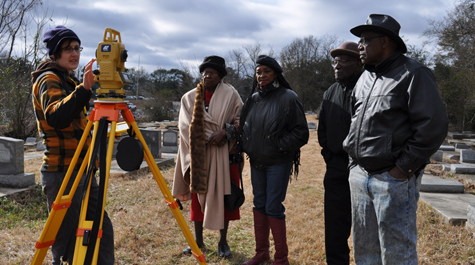 |
Public Archaeology Day and Alix Martin DemonstratingTotal Station Mapping at Old Plateau Cemetery, January 2010
|
Members of the Africatown Archaeological team will be in the
field in the summer of 2010 continuing investigations at the Lewis
Quarter and beginning excavations at the Cudjo Lewis House site. The
project has enjoyed funding from special grants from the Alabama State
Historical Preservation Office, Mobile County Commissioner Merceria
Ludgood, and the President of the Mobile African American Heritage Trail
Dora Finley.
 Skip to main content
Skip to main content
